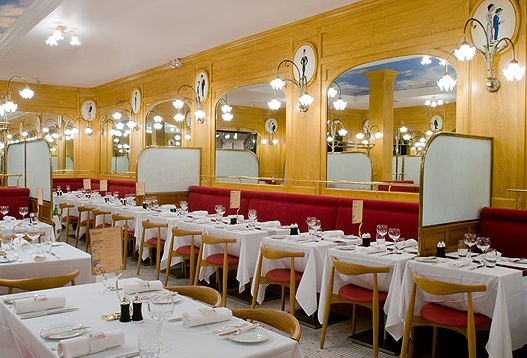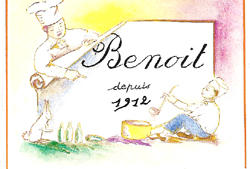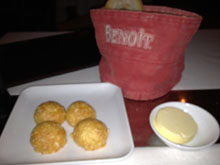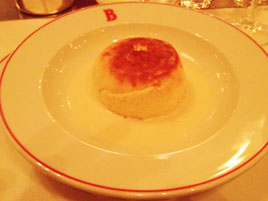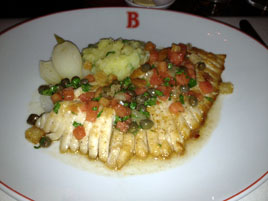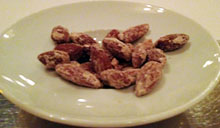You’ve got to hand it to Daniel Humm and Will Guidara, chef and restaurateur of the city’s hottest new restaurant, The NoMad: they know how to make an entrance, whether it be the Goodfellas-inspired promo video, or the publicity machine that generated eleven Eater.com posts in a nine-day span.
Humm and Guidara are the team behind Eleven Madison Park, which Frank Bruni elevated to four stars in 2009. The pair later bought out restaurant’s former owner, Danny Meyer, after they signed onto the NoMad project without their boss in tow. Meyer no doubt recalled a similar split, when Tom Colicchio opened Craft without him, while remaining the absentee chef at Gramercy Tavern: it was bound not to work in the long run, and this time Meyer chose not to delay the inevitable.
It’s news whenever a four-star chef opens a new place, but I don’t recall anything quite like the breathless coverage here. One month in, The NoMad is packed every evening, at almost any hour. It sets up gargantuan expectations that the restaurant might struggle to meet in the long run, after the excitement dies down and the chef is once again spending most of his time at the mother ship.
The NoMad is a major opening, no question about it. Although it lacks tablecloths, everything about it screams luxury. One of its five rooms, the Atrium, is “inspired by the great courtyards of Europe.” Another, the Parlour, is a “stately room featuring dark oak furnishings, richly textured fabrics and over 100 pressed antique herbs.” Yet another is an “intimate cove [with] the original fireplace imported from a great French château.” Or if not there, the “fully curated, two-level library connected by an original spiral staircase imported from the South of France.”
The staff, dressed in crisply pressed suits, look the part. Under GM Jeffrey Tascarella’s direction, they put on a well-choreographed show. I should note that Mr. Tascarella recognized me as soon as I arrived. I’d like to assume they do the same for everyone, but I can’t vouch for that: a couple in front of me was quoted a 45-minute wait to be seated for drinks in the library, whereas they accommodated me immediately. (At the bar, revelers were stacked three deep.)
The house cocktails ($15) are outstanding, including two of the best drinks with brown spirits that I’ve had in a long time, the Satan’s Circus (rye, chili-infused aperol, cherry heering, lemon) and the Old Alhambra (Islay scotch, vermouth, sherry, creme de cacao).
Like many a hotel restaurant, The NoMad will be serving three meals a day, plus (I assume) room service, which gives the owners many more meals over which to amortize their investment. Nevertheless, dinner is expensive here, with snacks $8–16, appetizers $14–24 and entrées $22–39. Only the vegetarian mains are under $30: Eater has already made its share of jokes about the $22 carrot entrée.
Breads, baked in-house, change daily. A flat mini-bread fried with fingerling potatoes and spring onions was as good as anything of its kind that we’ve had in a restaurant this year.


We started with one of the snack items, a rich Beef Tartare ($16; above left) with cornichons and horseradish, with crisp slices of toasted brioche to spread it on.
The house sent out a “Grande Plateau des Fruits de Mer,” normally $24 per person. I didn’t note the components, but it was far more impressive than your usual seafood platter, in that most of the items were composed, and were not just raw shellfish on the halfshell.


The kitchen also sent out two mid-courses, which I think were variants on the two vegetarian entrées on the normal menu: asparagus with button mushrooms; carrots and parsnip. These were the two best dishes we had all evening.


 A whole chicken for two ($78) is the restaurant’s signature dish, the only large-format item on the menu. The whole bird is presented tableside (above left), then sent back to the kitchen for plating (above right).
A whole chicken for two ($78) is the restaurant’s signature dish, the only large-format item on the menu. The whole bird is presented tableside (above left), then sent back to the kitchen for plating (above right).
It’s an impressive technical achievement, with truffle, foie gras, and brioche under the near-blackened skin. But just like the duck for two at Eleven Madison Park, one can’t help feeling that what comes back is rather meager, especially at the price.
There’s a whole Chowhound thread about the inconsistencies in this dish, which I wish I’d read in advance, as I might not have been so keen to order it. I didn’t really taste much foie gras or truffle. The chicken itself wasn’t bad, but the accompanying fricassee of dark meat (above) was not very pleasant at all. A few days later, we had the fried chicken at Peels, a much more satisfying dish that costs only $21.75.
We dined in the luxurious Parlour, which struck me as a much nicer space than the other main dining room, the Atrium, which is louder, and in which the tables seem closer together. There is much on this menu that I’d love to try. The chicken was a disappointment, but also an anomaly, as we loved everything else we tried.
The next evening, we dined at Café Boulud, which like The NoMad, is the next peg down the scale, below a four-star chef’s flagship. But whereas the former is small, quiet and understated, The NoMad is massive, brash, and a little exhausting. Messrs. Humm and Guidara must, of course, choose their own path, but it will be interesting to see if all of this excitement is sustainable.
The NoMad (1170 Broadway at 28th Street, NoMad)
Food: A focused Euro-American menu, just a notch below luxurious
Service: Crisp, correct, and attentive
Ambiance: An over-the-top dining palace, without the tablecloths
Rating: ★★
Why? Humm is a great chef, and there’s nothing in NYC quite like The NoMad
 Monday, June 10, 2013 at 06:34PM
Monday, June 10, 2013 at 06:34PM  The owner, Moscow native Andrey Dellos, inspires less confidence. He’s the guy behind the Meatpacking District horror Manon. He also owned Betony’s predecessor in this space, the lavish Russian-themed Brasserie Pushkin, which got mixed reviews, was ignored in The Times, and lasted just nine months.
The owner, Moscow native Andrey Dellos, inspires less confidence. He’s the guy behind the Meatpacking District horror Manon. He also owned Betony’s predecessor in this space, the lavish Russian-themed Brasserie Pushkin, which got mixed reviews, was ignored in The Times, and lasted just nine months. But the renovations are a half-measure that, I fear, has not gone far enough. Having invested enough in Brasserie Pushkin to buy a small château (around $5 million), Dellos apparently wasn’t willing to lose all of his sunk costs. So Betony is Brasserie Pushkin lite, the décor revised but still recognizably the same space.
But the renovations are a half-measure that, I fear, has not gone far enough. Having invested enough in Brasserie Pushkin to buy a small château (around $5 million), Dellos apparently wasn’t willing to lose all of his sunk costs. So Betony is Brasserie Pushkin lite, the décor revised but still recognizably the same space.






























































